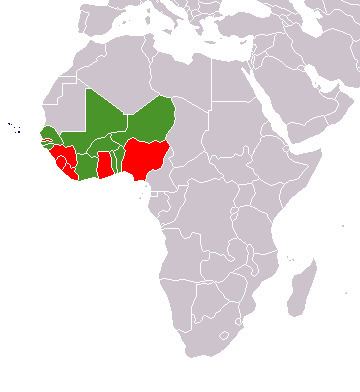 | ||
The Eco is the proposed name for the common currency that the West African Monetary Zone (WAMZ) plans to introduce in the framework of Economic Community of West African States (ECOWAS). After its introduction, the goal is to merge the new currency with the West African CFA franc (used by the French-speaking members of ECOWAS since 1945) at a later date. This will create a common currency for much of West Africa.
Contents
Ten criteria
For the Eco to be implemented, ten criteria, set out by the West Africa Monetary Institute (WAMI), must be met. These criteria are known as the Four Primary Convergence Criteria and Six Secondary Convergence Criteria. Up to the fiscal year 2011, only Ghana have been able to meet all the primary criteria in any single fiscal year.
The four Primary Criteria to be achieved by each member country are:
The six Secondary Criteria to be achieved by each member country are:
History of the currency
The goal of a common currency, first in the ECOWAS countries not using the West African CFA Franc (Ghana, Guinea-Conakry - which is French speaking but does not use the CFA Franc -, Liberia, Nigeria and Sierra Leone) and later in the whole ECOWAS area, was officially stated in December 2000 in connection with the formal launch of WAMZ. The Eco was first planned to be introduced in 2003, but this was postponed several times, to 2005, 2010 and 2014. At a meeting of the Convergence Council of Ministers and Governors of West Africa on 25 May 2009 the start of the currency was rescheduled to 2015 due to the international economic crisis. It was also planned at the December 2009 meeting that after the Eco is launched work will begin to merge it with the West African CFA franc; this was planned to be achieved by 2020.
In 2001 the West African Monetary Institute (WAMI) was set up with headquarters in Accra, Ghana. It is to be an interim organisation in preparation for the future West African Central Bank. Its function and organisation are inspired by the European Monetary Institute. In such a way that WAMI will provide a framework for Central Banks in the WAMZ to start the integration and begin preliminary preparations for the printing and minting of the physical money, just as EMI did before in the Eurozone before the introduction of the Euro. The current director general is Mr. J.H. Tei Kitcher.
However recent assessment of the member countries' efforts to meet the criteria are very bleak. The performance scorecard presented at the 2012 Annual Statutory Meetings of the WAMZ shows that GDP growth was projected to decline to 6.9% in 2012 from 8.7% in 2011. The convergence scale of the whole WAMZ area was also projected to go down from a score of 79.2% in 2011 to 62.5% in 2012; as no member met all the convergence criteria. The average annual inflation rate also increased from 11.6% in 2011 to 12.6% in 2012. The Director of Multilateral Surveillance ECOWAS Commission, Lassane Kabore, described the performance as "dismal" but he also affirmed the commitment of his commission to the establishment of the Eco.
